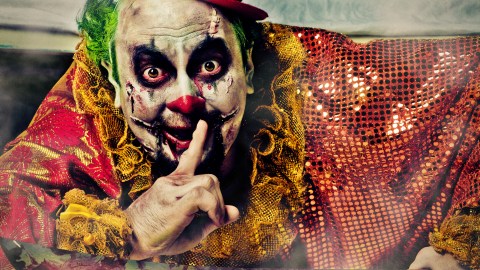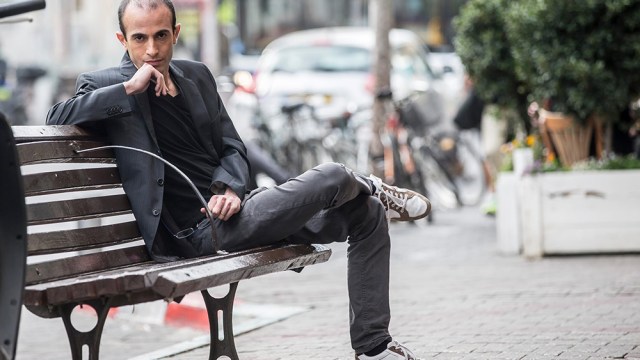I See Dead People: Halloween, Horror, and an App That Changes How We Frighten Ourselves

Fall is a pleasing season. It means sweaters, colder weather, and mugs filled with hot apple cider. While the leaves change from robust green to crunchy shades of gold and red, pumpkin spice drinks and foods reenter the argot of yuppies everywhere. For many of us, fall also signifies that Halloween is coming, and that means ghosts, zombies, and things that go bump in the night. We are enthralled with scaring ourselves and mobile technology is ushering in a new era of fright.
Humans are the only species capable of telling stories, and sometimes we like them terrifying. Consider the following:
A young boy is sleeping in his bed on a usual night. He hears footsteps outside his door, and peeks to see what is happening. His door swings open quietly to reveal a murderer carrying the corpses of his parents. After silently propping them up on a chair, the murderer writes something on the wall in the blood of the dead bodies and then hides under the child’s bed.
The boy is scared beyond belief. He can’t read the writing on the wall, and he knows the man is under his bed. Like any child, he pretends that he slept through the whole thing and hasn’t awoken yet. He lies as still as the bodies, hearing the quiet breathing from under his bed.
An hour passes and as the boy’s eyes adjust to the darkness, he tries to make out the words written on the wall, but it’s a struggle. He gasps when he finally makes out the sentence:
I know you’re awake.
We like fear. In 2014, the top 30 horror movies grossed almost $255 million from over 31 million tickets sold. And while factors like the opening weekend of its release, its production budget, and critical ratings influence how well a horror movie performs, a “slasher” themed flick will add about $15 million to its domestic box office revenue. Movies like Friday the 13th, Texas Chainsaw Massacre, and the Halloween series perform exceedingly well (and are arguably better love stories than the Twilight movies). My point, however, is that these movies tell chilling tales. Narratives are powerful things and when enhanced by technology, they can be horrifying.
Early this year, Novum Analytics sought funding through Indiegogo for “an ultra immersive gaming experience that transforms your environment into a terrifying hellscape.” Entitled Night Terrors and scheduled for release in 2016, Novum describes the game as a “highly immersive, photorealistic, binaural, augmented reality survival horror game for mobile devices. Gameplay takes place at home, after dark, with the lights off and your headphones on.”
Instead of watching a horror movie, imagine you’re in it. The idea is to use your phone to create a map of your house including walls, doors, floors, and ceilings. That information is then mashed up with game content, to put ghosts inside your home. Using your mobile phone’s LED flash, camera, and microphone, visual and aural information is ingested from your environment and then enhanced with game content to create visuals and audio to tell a petrifying story.
“I believe that good horror is about anticipation, uncertainty, and atmosphere. I’ve scared myself many times while walking around at night just testing the mapping algorithm,” writes Bryan Mitchell, the game’s designer. “Walking around in the dark, with the LED acting as the only light source and the microphone feed routed to the headphones is surprisingly unsettling all by itself.”
“The game might kill the LED for story reasons, play heavy breathing sounds (spatialized right behind the player), and have this thing move closer and closer to the player. As whatever that thing sniffing around in dark is looks for the player [sic], the player’s imagination does the heavy lifting.”
There are plans to measure a player’s heart rate (through Apple Watch), and the shakiness of a player’s hands (through the phone’s accelerometer) in an effort to cater the experience, to amp up the fright. Novum even plans to “measure, recognize, and respond to speech and facial expressions.”
As Mitchell says, “The game is designed to get inside the player’s head, which is why one of our tiers includes a personalized audio tier. A special thing happens when a person hears their own name and when a person becomes conscious of someone being conscious of them. These are experiences that don’t exist in film and have yet to reach their full potential in gaming.”
Premiering at Huber’s Museum in New York in December 1903, The Great Train Robbery revolutionized cinema. The scene at the conclusion of the film thrilled audiences. In it, the actor George Barnes points a gun directly at the camera and fires until his weapon is emptied of its rounds. Reportedly, when the audience saw Barnes point the gun and fire, they ducked and screamed. For the first time in movie history, the audience felt a part of the film, as though it was real life, and they clamored to watch it again.
Likewise, games like Night Terrors plunge players into a realistic, terrifying environment. Instead of watching a horror movie, players become a significant part of it. Using cool technologies, companies like Novum are changing how we experience entertainment. And I can’t wait to try it out.
_____________
I’d love to know your most terrifying, scary stories. The tales you tell every Halloween. Please leave them in the comments for everyone to enjoy.
Happy Halloween!! Muahahahahahah!!!!





